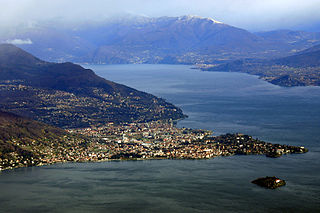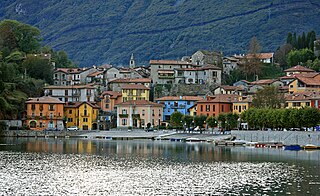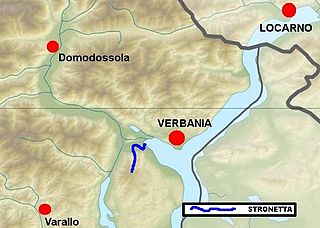Course
The torrent is formed by the confluence of two smaller streams, the Rio Valgrande and the Rio Pogallo, at Ponte Casletto in Val Grande. Its drainage basin comprises the areas of Val Grande and Val Pogallo; its course, and its tributaries are characterised by deep ravines and gorges.

A drainage basin is any area of land where precipitation collects and drains off into a common outlet, such as into a river, bay, or other body of water. The drainage basin includes all the surface water from rain runoff, snowmelt, and nearby streams that run downslope towards the shared outlet, as well as the groundwater underneath the earth's surface. Drainage basins connect into other drainage basins at lower elevations in a hierarchical pattern, with smaller sub-drainage basins, which in turn drain into another common outlet.
The San Bernardino passes through the communes of San Bernardino Verbano (which takes its name from the river), Cossogno and finally Verbania, where it separates the population centres of Pallanza and Intra and falls into Lake Maggiore.

San Bernardino Verbano is a comune (municipality) in the Province of Verbano-Cusio-Ossola in the Italian region Piedmont, located about 120 kilometres (75 mi) northeast of Turin and about 2 kilometres (1.2 mi) northwest of Verbania.

Cossogno is a comune (municipality) in the Province of Verbano-Cusio-Ossola in the Italian region Piedmont, located about 130 kilometres (81 mi) northeast of Turin and about 20 kilometres (12 mi) north of Verbania.

Verbania is the most populous comune (municipality) and the capital city of the province of Verbano-Cusio-Ossola in the Piedmont region of northwest Italy. It is situated on the shore of Lake Maggiore, about 91 km (57 mi) north-west of Milan and about 40 km (25 mi) from Locarno in Switzerland. It had a population of 30,827 at 1 January 2017.
This page is based on this
Wikipedia article Text is available under the
CC BY-SA 4.0 license; additional terms may apply.
Images, videos and audio are available under their respective licenses.

The Ossola [ˈɔssola] is an area of Italy situated to the north of Lago Maggiore. It lies within the Province of Verbano-Cusio-Ossola. Its principal river is the Toce, and its most important town Domodossola.

The Borromean Islands are a group of three small islands and two islets in the Italian part of Lago Maggiore, located in the western arm of the lake, between Verbania to the north and Stresa to the south. Together totalling just 50 acres in area, they are a major local tourist attraction for their picturesque setting.

Mergozzo is a comune (municipality) in the Province of Verbano-Cusio-Ossola in the Italian region Piedmont, located about 120 kilometres (75 mi) northeast of Turin and about 9 kilometres (6 mi) northwest of Verbania.

The Toce is a river in Piedmont, Italy, which stretches the length of the Val d'Ossola from the Swiss border to Lake Maggiore into which it debouches near Fondotoce in the commune of Verbania. The river is 83.6 kilometres (51.9 mi) long and is formed in the upper Val Formazza by the confluence of a number of torrents in the plain of Riale.

Lago di Mergozzo is a small sub-alpine lake in northern Italy just to the west of Lago Maggiore and north of Lago d'Orta, at the mouth of the Val d’Ossola in the province of Verbano Cusio Ossola, Piedmont.

The Giona is a ‘torrent’, or intermittent stream, which rises on the slopes of Monte Tamaro, in the Swiss canton of Ticino. After about 2 kilometres (1.2 mi), it enters the Italian province of Varese, forming the Val Veddasca before entering Lake Maggiore at Maccagno. Its course passes through the communes of Indemini in Switzerland and Veddasca, Curiglia con Monteviasco, Dumenza and Maccagno in Italy.

The Margorabbia is the river of Valtravaglia, a valley in
the province of Varese, Lombardy, Italy.
It is a tributary of the Tresa which it joins a few hundred metres upstream of Lake Maggiore.

The Isolino di San Giovanni is a small island belonging to the Borromean group of Lake Maggiore, one of the main subalpine lakes of northern Italy. It is situated some way to the north of the others in the group, 30 metres west of the shoreline of Pallanza, a frazione of Verbania. It is part of the frazione Pallanza.

The Giardini Botanici Villa Taranto are botanical gardens located on the western shore of Lake Maggiore in Pallanza, Province of Verbano-Cusio-Ossola, Italy. They are open daily; an admission fee is charged.

The Stronetta, or Rio Stronetta, is a small mountain torrent in the Province of Verbano Cusio Ossola, northern Italy.

The Melezzo Occidentale is a 13 km Alpine torrent which runs through the western part of the Val Vigezzo, a side valley of the Ossola in the Province of Verbano Cusio Ossola, northern Italy. Belonging to the Po basin, it is a left tributary of the Toce which in its turn flows into Lago Maggiore.

The Melezza, in Italy the Melezzo Orientale, is a 42 km Alpine torrent which runs through the eastern part of the Val Vigezzo, in the Province of Verbano Cusio Ossola, northern Italy; and through the Centovalli of Canton Ticino, Switzerland. Belonging to the Po basin, it is a tributary of the Maggia which in its turn flows into Lago Maggiore.

Verbania-Pallanza railway station serves the city and comune of Verbania, in the Piedmont region, northwestern Italy. Opened in 1905, it forms part of the Milan–Domodossola railway.

Val Grande National Park is a protected area located in Piedmont, in the north of Italy, at the border with Switzerland. It is most notable for landscapes of the High Alps.

CoEur is a devotional and hiking route in Italy and Switzerland. Its Italian subtitle, Nel cuore dei cammini d'Europa, translates as "In the heart of Europe's paths.



























